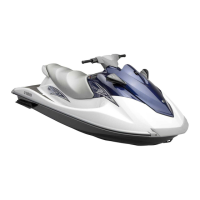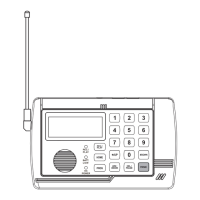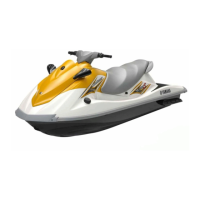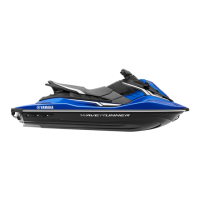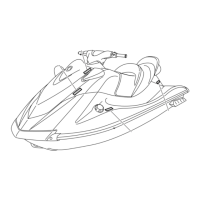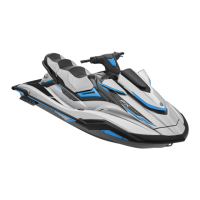Do you have a question about the Yamaha VX/VX Sport and is the answer not in the manual?
Details on PRI-ID, Hull Identification Number (HIN), and engine serial numbers.
Explains emission standards, labels, and California Air Resources Board (CARB) star ratings.
Illustrates the location of various critical labels on the watercraft.
Details various safety warning labels and their meanings.
Specifies age, supervision, and maximum passenger load for safe operation.
Guidelines for safe operation, speed, and awareness of surroundings.
Details required safety gear like PFDs, protective clothing, and eye protection.
Lists essential safety equipment to carry on board for emergencies.
Alerts to hazards like exhaust fumes and explains jet propulsion and steering.
Provides safety precautions and requirements for water-skiing with the watercraft.
Introduces waterway navigation rules for safe operation and collision avoidance.
Lists organizations and resources for obtaining additional boating safety information.
Emphasizes responsible riding, courtesy, and environmental care for enjoyable use.
Identifies key external components from front and rear views.
Details the location and function of the main controls like switches, levers, and the information center.
Illustrates and identifies major components within the engine compartment.
Explains how to remove/install the seat and open/close the hood.
Describes filler cap operation and the use/care of the remote control transmitter.
Details the operation of the engine stop and shut-off switches for safety.
Explains start switch, throttle lever, and cooling water pilot outlet functions.
Explains steering mechanics and the operation of the shift lever for forward/reverse.
Describes the handgrip and bow/stern eyes for boarding and securing.
Covers YEMS, Security System, and Low-RPM mode for VX Deluxe/Cruiser.
Explains how to select between normal and low-RPM modes using the remote transmitter.
Details indicators like tachometer, speedometer, fuel level, and warning lights.
Describes front and glove compartments, capacity, and waterproofing limitations.
Details recommended fuel types, octane ratings, and engine oil specifications.
Provides instructions on how to safely refuel the watercraft and its capacity.
A checklist of essential checks before launching or operating the watercraft.
Step-by-step instructions for performing critical pre-operation checks.
Explains how to check the engine oil level and potential issues with over/underfilling.
Instructions for checking and draining the water separator and bilge.
Procedures for checking drain plugs and battery condition, leads, and breather hose.
Details fire extinguisher requirements and checking throttle lever operation.
Procedures for checking steering system and shift lever/reverse gate.
How to check jet intake for debris and inspect the engine shut-off cord.
Verifies operation of switches, cooling outlet, and multifunction information center.
Essential engine break-in steps and procedures for safely launching the watercraft.
Critical safety steps and procedures for starting the watercraft engine.
Instructions to stop the engine and secure the watercraft when leaving.
Introduces basic operation, safety, load limits, and learning practices.
Guidelines for operating with passengers and safe engine starting procedures.
Steps for boarding and starting in shallow water, from dock, and in deep water.
Instructions for boarding the watercraft by yourself or with passengers.
Procedures to safely right a capsized watercraft and prevent engine damage.
Explains how steering control is achieved through handlebar and throttle input.
Instructions for stopping, beaching, and docking the watercraft safely.
Guidance for operating in rough water and performing post-operation cleaning and flushing.
Guidelines for safely securing and transporting the watercraft on a trailer.
Instructions for preparing and storing the watercraft for long periods.
Explains the importance and process of flushing the cooling system to prevent clogging.
Details on lubricating various parts of the watercraft for smooth operation.
Checks for fuel system, oil changes, and filter replacement.
Steps for checking, cleaning, charging, and storing the battery.
Instructions for cleaning the watercraft and overview of maintenance/adjustments.
Advises carrying the manual and tool kit and their storage location.
A chart outlining recommended maintenance tasks based on hours or months of use.
Specific checks for fuel tank, hoses, and air bleeding passages for leaks.
Guidance on changing engine oil and replacing the oil filter, including specifications.
Procedures for servicing air filter, checking nozzle angle, and shift cable.
Steps for adjusting throttle cable and cleaning/adjusting spark plugs.
Specific points for applying water-resistant grease to moving parts.
Instructions for checking battery electrolyte level and lead connections.
States that fuel injection system adjustments should be done by a dealer.
How to check and adjust the watercraft's trolling speed.
Detailed technical specifications for capacity, dimensions, engine, and drive unit.
Provides a chart to diagnose and resolve common watercraft problems.
Steps for clearing weeds/debris from the jet intake and impeller during emergencies.
Instructions for jump-starting a dead battery using jumper cables and a booster battery.
Details the location of fuses and how to replace a blown fuse with the correct amperage.
Guidelines for safely towing an inoperative watercraft to shore.
Steps to take if the watercraft becomes submerged, including dealer inspection.
Explains the terms, coverage, exclusions, and responsibilities of the limited warranty.
Information on obtaining warranty service and updating owner contact details.
Information on optional extended service plans for enhanced coverage after the warranty expires.
Details on PRI-ID, Hull Identification Number (HIN), and engine serial numbers.
Explains emission standards, labels, and California Air Resources Board (CARB) star ratings.
Illustrates the location of various critical labels on the watercraft.
Details various safety warning labels and their meanings.
Specifies age, supervision, and maximum passenger load for safe operation.
Guidelines for safe operation, speed, and awareness of surroundings.
Details required safety gear like PFDs, protective clothing, and eye protection.
Lists essential safety equipment to carry on board for emergencies.
Alerts to hazards like exhaust fumes and explains jet propulsion and steering.
Provides safety precautions and requirements for water-skiing with the watercraft.
Introduces waterway navigation rules for safe operation and collision avoidance.
Lists organizations and resources for obtaining additional boating safety information.
Emphasizes responsible riding, courtesy, and environmental care for enjoyable use.
Identifies key external components from front and rear views.
Details the location and function of the main controls like switches, levers, and the information center.
Illustrates and identifies major components within the engine compartment.
Explains how to remove/install the seat and open/close the hood.
Describes filler cap operation and the use/care of the remote control transmitter.
Details the operation of the engine stop and shut-off switches for safety.
Explains start switch, throttle lever, and cooling water pilot outlet functions.
Explains steering mechanics and the operation of the shift lever for forward/reverse.
Describes the handgrip and bow/stern eyes for boarding and securing.
Covers YEMS, Security System, and Low-RPM mode for VX Deluxe/Cruiser.
Explains how to select between normal and low-RPM modes using the remote transmitter.
Details indicators like tachometer, speedometer, fuel level, and warning lights.
Describes front and glove compartments, capacity, and waterproofing limitations.
Details recommended fuel types, octane ratings, and engine oil specifications.
Provides instructions on how to safely refuel the watercraft and its capacity.
A checklist of essential checks before launching or operating the watercraft.
Step-by-step instructions for performing critical pre-operation checks.
Explains how to check the engine oil level and potential issues with over/underfilling.
Instructions for checking and draining the water separator and bilge.
Procedures for checking drain plugs and battery condition, leads, and breather hose.
Details fire extinguisher requirements and checking throttle lever operation.
Procedures for checking steering system and shift lever/reverse gate.
How to check jet intake for debris and inspect the engine shut-off cord.
Verifies operation of switches, cooling outlet, and multifunction information center.
Essential engine break-in steps and procedures for safely launching the watercraft.
Critical safety steps and procedures for starting the watercraft engine.
Instructions to stop the engine and secure the watercraft when leaving.
Introduces basic operation, safety, load limits, and learning practices.
Guidelines for operating with passengers and safe engine starting procedures.
Steps for boarding and starting in shallow water, from dock, and in deep water.
Instructions for boarding the watercraft by yourself or with passengers.
Procedures to safely right a capsized watercraft and prevent engine damage.
Explains how steering control is achieved through handlebar and throttle input.
Instructions for stopping, beaching, and docking the watercraft safely.
Guidance for operating in rough water and performing post-operation cleaning and flushing.
Guidelines for safely securing and transporting the watercraft on a trailer.
Instructions for preparing and storing the watercraft for long periods.
Explains the importance and process of flushing the cooling system to prevent clogging.
Details on lubricating various parts of the watercraft for smooth operation.
Checks for fuel system, oil changes, and filter replacement.
Steps for checking, cleaning, charging, and storing the battery.
Instructions for cleaning the watercraft and overview of maintenance/adjustments.
Advises carrying the manual and tool kit and their storage location.
A chart outlining recommended maintenance tasks based on hours or months of use.
Specific checks for fuel tank, hoses, and air bleeding passages for leaks.
Guidance on changing engine oil and replacing the oil filter, including specifications.
Procedures for servicing air filter, checking nozzle angle, and shift cable.
Steps for adjusting throttle cable and cleaning/adjusting spark plugs.
Specific points for applying water-resistant grease to moving parts.
Instructions for checking battery electrolyte level and lead connections.
States that fuel injection system adjustments should be done by a dealer.
How to check and adjust the watercraft's trolling speed.
Detailed technical specifications for capacity, dimensions, engine, and drive unit.
Provides a chart to diagnose and resolve common watercraft problems.
Steps for clearing weeds/debris from the jet intake and impeller during emergencies.
Instructions for jump-starting a dead battery using jumper cables and a booster battery.
Details the location of fuses and how to replace a blown fuse with the correct amperage.
Guidelines for safely towing an inoperative watercraft to shore.
Steps to take if the watercraft becomes submerged, including dealer inspection.
Explains the terms, coverage, exclusions, and responsibilities of the limited warranty.
Information on obtaining warranty service and updating owner contact details.
Information on optional extended service plans for enhanced coverage after the warranty expires.
